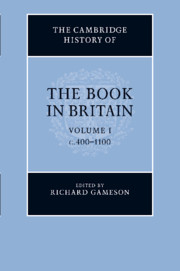Book contents
- Frontmatter
- 1 From Vindolanda to Domesday: the book in Britain from the Romans to the Normans
- PART I THE MAKING OF BOOKS
- 2 The material fabric of early British books
- 3 Anglo-Saxon scribes and scriptoria
- 4 Writing in the Insular world
- 5 Script in Wales, Scotland and Cornwall
- 6 English vernacular script
- 7 Latin script in England c. 900–1100
- 8 The design and decoration of Insular gospel-books and other liturgical manuscripts, c. 600 – c. 900
- 9 The decoration of the earliest Welsh manuscripts
- 10 Book decoration in England, c. 871 – c. 1100
- 11 Bookbindings
- PART II THE CIRCULATION OF BOOKS
- PART III TYPES OF BOOKS AND THEIR USES
- PART IV COLLECTIONS OF BOOKS
- PART V CODA
- Bibliography
- Concordance of named manuscripts
- Index of manuscripts
- General Index
- Plate 4.1: The Lindisfarne Gospels"
- Plate 5.1: The Lichfield/St Chad Gospels"
11 - Bookbindings
from PART I - THE MAKING OF BOOKS
Published online by Cambridge University Press: 28 March 2012
- Frontmatter
- 1 From Vindolanda to Domesday: the book in Britain from the Romans to the Normans
- PART I THE MAKING OF BOOKS
- 2 The material fabric of early British books
- 3 Anglo-Saxon scribes and scriptoria
- 4 Writing in the Insular world
- 5 Script in Wales, Scotland and Cornwall
- 6 English vernacular script
- 7 Latin script in England c. 900–1100
- 8 The design and decoration of Insular gospel-books and other liturgical manuscripts, c. 600 – c. 900
- 9 The decoration of the earliest Welsh manuscripts
- 10 Book decoration in England, c. 871 – c. 1100
- 11 Bookbindings
- PART II THE CIRCULATION OF BOOKS
- PART III TYPES OF BOOKS AND THEIR USES
- PART IV COLLECTIONS OF BOOKS
- PART V CODA
- Bibliography
- Concordance of named manuscripts
- Index of manuscripts
- General Index
- Plate 4.1: The Lindisfarne Gospels"
- Plate 5.1: The Lichfield/St Chad Gospels"
Summary
Among the tenth-century notes added to the end of the Lindisfarne Gospels is one concerning the production of the manuscript:
Eadfrith … originally wrote this book … And Æthilwald … impressed it on the outside and covered it … And Billfrith … forged the ornaments which are on it on the outside and adorned it with gold and with gems and also with gilded-over silver – pure metal.
Whatever the status of this text, the inclusion of the names of a binder and a goldsmith is very unusual among pre-Conquest records of book production. A binder would have covered the ‘outside’ of a manuscript – the Lindisfarne text does not specify with what, and the meaning of ‘impressing’ the cover is uncertain – and a goldsmith would have decorated it. However, a binder would usually do more than merely covering the outside, although his other work is mostly invisible when completed. There are four main operations in binding a manuscript: first, sewing the quires together; second, attaching the boards (which may or may not have been made by the binder); third, covering the boards; and, last, decorating the covers. Æthilwald was only attributed the third of these operations in the Lindisfarne text, and Billfrith was credited with the fourth.
Keywords
- Type
- Chapter
- Information
- The Cambridge History of the Book in Britain , pp. 294 - 310Publisher: Cambridge University PressPrint publication year: 2011



